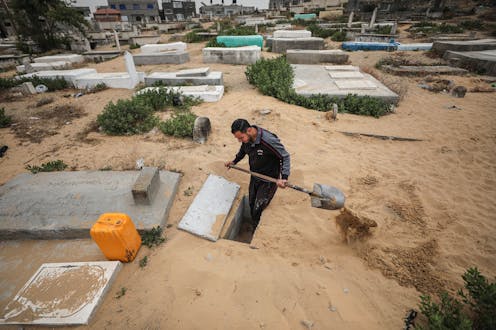Young people in the Middle East struggle to see a promising future
Political and economic forces across the Middle East and North Africa combine to mean well-educated young people spend years looking for work, which delays their independence and adulthood.

The Middle East’s population is growing almost twice as fast as the world overall, and one-third of its people are under the age of 15.
As Joe Biden takes his first trip to the region as president, he plans to focus on the prospects for peaceful international relations. A key factor often overlooked is the Middle East’s lack of opportunities for young people.
As a scholar who has spent almost 20 years studying conflict, migration and youth in the Middle East, I believe their frustration could ultimately lead to an international crisis way beyond the borders of the region.
A rapidly changing situation
The region encompassing the Middle East and North Africa is diverse economically, geographically, historically, politically and socially, and often fraught with tension. Most of the major armed conflicts in the last decade have occurred there – apart, obviously, from Russia’s invasion of Ukraine.
Since the pro-democracy protests and uprisings of the Arab Spring in 2010, the region has experienced some sort of significant conflict in eight of its 21 countries: Egypt, Iraq, Lebanon, Libya, Palestine, Syria, Tunisia and Yemen.
In addition, the region’s population is growing at a much faster rate than the global average – and has been since the World Bank began keeping records in 1961. Its people now number over 450 million, up from 300 million in 2001.
Widespread youth unemployment
The region’s young workers – those from ages 15 to 24 – already struggle with the highest unemployment rates in the world, averaging 25%. Thirteen countries in the region have a youth unemployment rate of at least 20%, with the rate above 50% in Libya, above 40% in Jordan and Palestine, and above 30% in Algeria and Tunisia.
And more young workers are on the way.
The World Bank estimates that to provide employment for those currently out of a job and those who will soon be seeking work, Middle Eastern and North African nations need to create more than 300 million new jobs by 2050. This number is almost twice as many jobs as are currently in the U.S.

Economic struggles
The struggle of high youth unemployment in the region is not a new challenge. Local and international governments and organizations have tried for years to create more opportunities for young people, but with little success.
In many Middle Eastern nations, regulations and laws about hiring and firing workers discourage employers from creating new jobs when times are good, for fear they’ll have to keep those people employed when times get worse again. Other rules discriminate against young women seeking work. Education and training programs don’t always line up with the jobs that are available.
In many countries, the government is the one of the largest employers. In Egypt, Tunisia and Syria, government jobs are almost one-third of all employment. In Egypt, government work accounts for 70% of nonagricultural jobs. In most countries, government jobs pay about 20% less than private industry, but in the Middle East, government jobs pay about 30% more on average. This means people will often just wait for a public sector job instead of taking available private sector jobs.
Even those young people who manage to get jobs say they often are searching for several years before landing work. During this time, they rely on financial support from their families. This causes them to experience what has been called “prolonged adolescence,” in which they are unable to develop financial and social independence, such as moving out and getting married, until their 20s or even their 30s.
Other compounding challenges
The region faces other obstacles that make it even harder for governments to tackle youth unemployment.
In addition to internal conflict, the International Monetary Fund reports that several of the region’s countries – including Egypt, Iraq and Tunisia – are facing a slow economic recovery from the pandemic, inflation in the costs of basic commodities such as energy and food, and financial and debt obligations needed to stabilize the economy.
Several countries across the region – including Algeria, Libya, Jordan, Kuwait, Saudi Arabia, Qatar, Oman, the United Arab Emirates and Yemen – have less water than their populations need.
There are other environmental concerns, such as pollution, agriculture land scarcity and poor public infrastructure, which hinder sustainable economic growth.
The crisis in Ukraine threatens food supplies. More than one-third of Egyptians’ diets are based on wheat, but 85% of Egypt’s wheat comes from Russia and Ukraine. Supplies have been reduced, and prices are expected to rise on bread and other wheat-based staple foods.
All these problems have contributed to varying degrees of lack of public confidence in the economies in the region. For instance, in a nationally representative survey, 78% of Iraqis describe the economic situation in their country to be either bad or very bad. In Yemen, that proportion is 68%.
Read more: Russia-Ukraine crisis poses a serious threat to Egypt – the world’s largest wheat importer
Potential effects
Often the way to improve young people’s prospects is education. But in several Middle Eastern countries, including Egypt, Jordan and Tunisia, university-educated young people have a higher unemployment rate than their less-educated peers because most of the available opportunities are for low-skill jobs.
Rather than bringing higher earnings, education for Middle Eastern young people can deliver frustration.
It’s no surprise, then, that vast numbers of young people – at least one-fourth of young Egyptians, Iraqis and Yemenis, and more than 60% of Lebanese youth – are looking to emigrate, often to Europe.
All these forces at work in the Middle East – economic pressures, political conflict and water shortages – have the potential to spread international tension, refugees seeking safety and opportunity, or even disease. The challenges facing Middle Eastern nations are all made more difficult by the lack of faith their young people have in the prospect of a fulfilling future at home.
Georges Naufal is a research fellow at the IZA Institute of Labor Economics and Economic Research Forum.
Read These Next
West Antarctica’s history of rapid melting foretells sudden shifts in continent’s ‘catastrophic’ geo
A picture of what West Antarctica looked like when its ice sheet melted in the past can offer insight…
How the ‘slayer rule’ might play a role in determining who will inherit wealth from Rob Reiner and h
These rules have a long history in the United States. They played a role in the notorious murders by…
From truce in the trenches to cocktails at the consulate: How Christmas diplomacy seeks to exploit s
World leaders like to talk up peace at Christmastime. But alongside the tales of seasonal breaks in…






